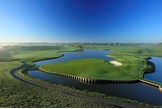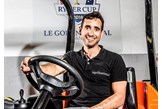Greenkeeper secrets of Paris National’s set-up
Published: Last updated:
He won’t touch a club in Paris, but Head Greenkeeper Alejandro Reyes will play a huge role in the result.
The Spaniard is in his sixth year as the head greenkeeper at Le Golf National and he’s spent the bulk of that time preparing to deliver one of the most exciting Ryder Cups of all time.
His dream? “That both teams will be happy with the way the course is set up, my team receives the recognition they deserve for the job they’ve done, beautiful weather and another historic finish similar to the one at Medinah.”

The course set-up
This is a tee shot golf course. It wouldn’t make sense for us to set up the course as they did at Hazeltine (wide fairways, little rough); in some ways it will be the opposite. It will be similar to what we had for the French Open. The fairways will be the same width as in 2016, when they were narrowed. Nothing has changed from then – it’s already one of the tightest courses on the European Tour. The set-up for the Ryder Cup isn’t easy, because at the end of September the possibility of rain is quite high so improving the drainage was a major priority.
The preparation
I’ve sought advice from several previous Ryder Cup head greenkeepers asking what they changed in the tournament set-up and hopefully learning from any mistakes. It’s been great to share the knowledge. We’ll close the course 20 days before the Ryder Cup to make sure everything is right – I’d like to close it a bit earlier to be honest, but we are a pay-and-play course so this is very difficult.
Tournament routine
On competition days we’ll be on the course at 6 to 6.30am and working an hour in front of the first matches… we don’t want to set up the course too early. The most important thing is the consistency from the putting green to the first tee to the 18th green. All the greens should be of the same firmness, the same humidity and the same speed.
The greens
We have six semi-island greens with water very close, six greens with run-offs and six protected by bunkers and rough, the way it was designed. The greens are huge – on average 700m2… very big! They have subtle rather than significant undulations, but you do need to read them carefully. The greens are quite firm – I can’t comment on the likely speed.
The rough
I don’t think the rough will be any more dense than it was for the French Open, but there might be more of it. In the medium rough you can get out, but if the greens are firm enough you won’t be able to stop it on them. We are keeping a clean, well maintained “rough” around the greens.
Course changes
The length is still the same, but new tee boxes have been created to change the angle of the tee shot for spectator reasons. We added two new pot bunkers on the 18th fairway ready for the Ryder Cup – any golfer finding them won’t have a shot into the green. We’re not putting obstacles in place for the American team, but looking to create more drama and excitement… There are around 45 bunkers on the course, and they’ve all been reshaped. Previously from the middle of the fairway, you couldn’t see many bunkers around the green. Now, after the renovation project (2015-16), you can see them all. Also, the 1st and 16th greens are new.
The wind
The direction can change from day to day. On the long par-4 17th into the wind, Greg Norman hit driver and 3-wood, but still didn’t make the green! He told the architect it was a badly designed hole, believing there’s not a par 4 in the world he couldn’t reach in two. However, the next day the wind totally changed and he found the green with driver and 7-iron…
Key holes
We really hope many matches will go down the closing holes. About 45% of Ryder Cup matches actually go down the 18th, while most should go down 15, which is another spectacular hole… and hopefully 16, a testing par 3 over water, 17 with its narrow fairway with high rough on both sides and the amazing 18th, a natural stadium.
Best birdie chances
They’re on the front nine. Five and six are short par 4s and though both have small greens, the big hitters could be tempted to go for them. Players will also be looking to get on the par-5 3rd in two despite the narrow fairway, water on the right and heavy rough on the left, and the par-5 14th – though a lot depends on the wind.
Handling the pressure
I used to sleep all right, but the past month not so well! This is the biggest challenge of my life, and I’m very lucky – not many people get the chance to deliver the Ryder Cup, but I have to say I have a great team of 30 greenkeepers behind me.




